Hello lovelies. I landed upon this page on African-American folk artists this week and while I have not fully immersed in all of it…it’s a very rich page on a very rich site, I had to share it before class!
Enjoy!

Hello lovelies. I landed upon this page on African-American folk artists this week and while I have not fully immersed in all of it…it’s a very rich page on a very rich site, I had to share it before class!
Enjoy!
Hi all…here are a few things I have been playing with, trying to feel more comfortable with experimenting with the kids’ words and some images along with my own ideas and layers…
Playing with words and images
My photos are being naughty and not uploading properly so here they are in a google slide show…more boring, I know! I will put the pictures directly in this message once they upload properly!
For these two, I wanted to take the images the kids had either taken or chosen and place them with their words. But as I studied them I realized that both the images and words lay atop historical contexts within and outside the community.
These images are historical and rooted in a specific place.
In the first one, the background is of a historical marker of Freedman’s Village where the Green Valley Pharmacy still lives.
In the next slide, the image is not actually in Arlington but Joanie’s presence in the picture is carried with her across time and place to live in Arlington as F sees it.
Found Poem
While this is not visual…yet, I wanted to share where I am with this. The jumps of time from her being in the present, thinking about the future based on her past…makes me really want to explore this visually.
T was in my first class at Patrick Henry Elementary School (PHES) in 2011-2012. We have continued to chat and email over the years as she visited the school after she left and kept in contact once I moved to New York. I conducted an interview with her about PHES and we discussed the possible transition of the school to a new location. After transcribing the interview, I played the audio while reading the text and highlighted words and phrases that “stuck out” to me and seemed to resonate either on the page or because of the intonation of T’s voice. I then lifted the highlighted parts and placed them on a new page…below is the new “cooked” poem.
My entire life from whatever I can remember…
I remember being there.
one of my first memories
was Patrick Henry…
really good memories…
being really comfortable
because I know every nook and cranny
of Patrick Henry
not just because of the building
…because of the people there
But, still, I have a connection towards the actual building.
there’s Patrick Henry that I can hold on to
and then I will always remember how good Patrick Henry was.
How much I grew up there.
I can thank Patrick Henry for so many things that make me who I am.
I thought that when I’m older and eventually if I end up having kids, then my kids are gonna go here.
They’re gonna to a place just like Patrick Henry.
But…people aren’t going to be going to Patrick Henry anymore.
There isn’t going to be a Patrick Henry anymore.
Like, I have to be okay.
I just didn’t realize it was gonna be a problem for me right now.
There’s things like that I remember.
But I think I have more connection towards like…
just like everyday after school.
Things like that.
I know everybody has those memories
with their elementary school,
with their middle school
or whatever.
It just feels like a lot right now.
It is really hard for me to post because it’s been a rough week. There were even cops and ambulances involved.
This week I have led several conflict circles, harm circles and healing circles with our young third graders.Students shared their pain and what makes their heart hurt.
They shared stories of daily domestic violence that they witness between parents, stories of missing their fathers, stories of being told they are stupid, stories of not always being able to eat “good” food, stories of cops being called constantly because of violence in the home, stories of feeling unwanted and unloved. I am emotionally drained, feeling a bit hopeless from these circles with students.
I collected more drawings and words of what hope means from other third graders in my school that i indirectly teach, yet see every day full of smiles, hugs and love. Reading their hopes today, is slowing uplifting my spirit. If you’re having a rough week, read some of their hopes, maybe it will uplift you.
I’m still thinking about my final project and trying to piece together something that can visually be shown for our potential exhibition next spring.
Click on the link below:
This week, my aim is to build momentum in the incorporation of visual-based feedback in self-reflection from my freshman mathematics students. They appeared invested in the first exercise of this visual self-reflection, as reflected in these selections from that reflection I posted earlier: Visual Self-Reflection Expression.
Here is the second prompt I plan to administer this week in follow-up: Visual Self-reflection #2.
Any feedback appreciated.
See you all soon,
Luis
Gregory
I think the two photos that Gregory posted are spectacular and really made me consider the artistry of the photographer-subjects. The photographs are beautifully framed and posed, they each evoke pride and care though their flavors are very different and I will be curious to know how all of you see and feel them. I am taken by the high bar fence in the photo on the left that implies it is guarding a building of importance and yet the house seems a family house – old and modest, the basement doors (panels) clearly worn. The photographer-subject stands in front of the fence, removed from a building that most hold importance for her and indicating a separation that wasn’t always there. I can’t quite read her expression (does she have a trace of a smile? Is there a bitterness?), but the light pouring in on the right, shadowing the fence and reflecting of her glasses and bounding up the stairs also evokes the passing of time, maybe one of light and dark. It is interesting that her coat is almost all in dark except for opening that is lined in light; her coat is not closed, she is again inside and outside. Very beautiful photo that almost playfully is lined up with the very different photo on the right so that the light from one photo almost seeps into the next.
The photo on the right shows the subject at work, with craft, skill and beauty all central to her task-profession-desire, working with what might be lace- fragility. She is working with hands, paying careful attention. Again she’s framed the photo carefully, its center directly between her and her manikin. The lamp, off-center and tilted is also very beautiful. The light though comes not from that lamp but, briefly, from the window. I can’t quite tell if there are flowers on a distant table and if that is a door on the right. I need to see both these photos more clearly. There is a peace and contentment about this photo; it is not as tense for me as the one on the left. There is a quiet dignity and self-awareness, however, in both images.
Lamar
Picasso said that he spent all his adult life trying to learn how to draw like a child again, and we see in the drawings of Lamar’s students why this might be a goal. These drawings are so full of joy even though so many address tragedy. These students are not afraid of color, and they draw with abandon- people as big as the houses they are next to, pages filled with both scribble and renderings, no obvious needs for rendering perfection but the message is radiantly clear and perfect in its own right. Valerie, who writes that “I have a dream to end world hunger” drew an image that reminds me of Edvard Munch’s Scream; I imagine the text written as if it were a scream. I wonder if Valerie might think about doing that or if she even thinks of her image as screaming.
Some of the texts really stood out for me: Hope is when you never stop believing in someone; Hope is something you fight for; Hope is when you can achieve other things; Hope feasts like an eagle; Hope means drawing; Hope means happiness. These statements make me think of the work of Barbara Kruger and Jenny Holzer, and you might want to look at their work.
When one of the students includes within her incredible painting the call to “stop selling cigarettes” I couldn’t but help think of Eric Garner.
I love the way, Lamar, you are pursuing this project. I think your questions for your students are good questions, and recording their answers would be great too. I wonder if it might be a good idea to set aside a time for a “reading circle” in which the students would read (and show) what they wrote (and drew) and talk about it. This would be less formal than asking them specific questions but might give you something a bit different. You could also have a performance circle. What would happen if you created collages based on everyone’s images and text, or posters with the images demanding action that were put around the school (or community)? You could invite parents to the reading circles. Your questions and any of these activities would keep pushing on self-reflection while also evoking, for others, what these very young students are grappling with.
I don’t want you to forget about floating copies of these drawings as an exhibition possibility. How would you do that?
It’s been a long time since I’ve used imovie, but it probably is the best program to use since it is very accessible. It will take some work to get used to it, but I am very excited by the possibilities it offers.
Dahlia:
I love this quote from Toni Cade Bambara that Dahlia offers. It reminds me of Emma Goldman, one of our greatest activists and anarchist extraordinaire who wrote that a revolution without dancing isn’t a revolution that’s worth having. As artists and revolutionaries, this might be one of the most important considerations to keep in mind.
Aderinsola
Part of the reason why I wished I had recorded our last class was because the questions that Aderinsola was posing to Wendy, and the prosody of her voice as she posed them, were not only richly critical and direct but also could have been used as voice-overs in her own work. Also they could have been used, in manipulated forms, as separate voice files that challenge the role of the researcher, and in particular the white researcher (though the questions Aderinsola poses have pertinence for all researchers). Why is it that so many progressive white researchers choose to spotlight young people of color? Is this a progressive act, an act of solidarity? Is it undertaken from a sense of guilt or responsibility? Is it exploitative? Who benefits from the research and how do the benefits and costs balance out? Does a balancing in favor of benefit negate the cost? Who decides? Is there a savior-sense to the undertaking? A sense of self-satisfaction? Is it the best that a white researcher can do? Do these same questions plague researchers of color albeit with variation? Is there something else that we think researchers and white researchers should do if the social justice that Anderinsola writes about and that Lamar’s students draw and write about is our primary goal. Where does joy fit in? Is the job of a researcher to make sure that the research participants speak for themselves (as Lamar wants his students to do) and does Wendy’s whiteness, per se, preclude that possibility? Is curation a bad idea? What does Aderinsola mean by a “collective voice?”
From the first time I met Aderinsola a number of years ago I was struck by her refusal to just ride the waves of graduate school. I was also impressed by her persistent challenge of whiteness within the Academy. Her questions posted here are a continued problematizing of positionality and the right (legitimacy) of white researchers to study others. These questions do not have easy or simple answers, but we all need to continue to think about them.
I was attending a panel discussion on whiteness in the Academy. Asilia Franklin-Phipps, who will be visiting us toward the end of the semester, was one of the panelists. One of her co-panelists stated that if you are white and want to be in solidarity with communities of color you need to do so as an “accomplice.” I do not think that unpacking that concept is easy. What does it mean to be a researcher-accomplice? Do researchers of color not struggle with this issue as well though clearly from a different position?
Aderinsola- I am looking forward to the next iteration of your project and curious if any of these issues will infiltrate it.
Noor
Noor’s post and that of Aderinsola grapple with some of the same issues though move in different directions. Images (Wendy’s photos, my drawings and collages) can be viewed as exploitative and voyeuristic like historic photos of black women and girls but Noor emphasizes the reflexivity of the girls and Wendy’s self-reflexivity as a qualitative difference from those older photographs that has potential for generating (evoking?) insight that is non-reductive though issues of curating and complicity still remain troublesome. Mirzoeff’s The right to look addresses Noor’s efforts to challenge white hegemony, but hegemony – obviously – is a formidable force and combating it demands constant awareness and self-scrutiny. I think Noor’s emphasis on the process, on creating spaces where reflexivity and curiosity bloom, is central to the countervisual and to counter narratives.. Creating what Noor is calling a “real question” helps facilitate that ambiance, and it is something for all of us to consider (I am thinking specifically right now about Lamar’s project though Dahlia’s is prominent in my mind at the moment).
I listend to the Sanctuary sound track that Noor provided the link to and they reminded me of Lamar’s freedom dreams. I’ve always thought of sanctuaries as being, by definition, counter-spaces, escapes from unfreedom and yet many of those who discussed sanctuary envisoned it as the dominant space, without borders, a space infused with love and in which displacement contradicts its very essence. Did Wendy help create sanctuary spaces for those she worked with, are we doing that in our projects? Can arts-based research, infused with the awareness that both Noor and Aderinsola discuss, help create a revolutionary space that is irresistible as Toni Cade Bambara demands?
Noor is running the marathon today. I look forward to hearing, Noor, how it all went. I’m rooting for you.
Gene
Hello,
The actual work of capturing, collecting , acquiring of portraits continues, as well as the development of the project, and its message and meaning explored from the intention(s) of the subject (self portrait) and its audiencing. After seeing Luttrell’s presentation last week, I am ever cautioned of recognizing the impossibility of erasing the researchers positionality from the work, and yet I am encouraged that even so, the work and its goals can be met, and my role and influence be made transparent and addressed in a manner that honors the intent of the work.
As Lamar asked in his post, I have asked my subjects to consider and reflect on their art and its implicit personal narrative, versus what they think someone experiencing their art/image might derive without any additional information/knowledge
.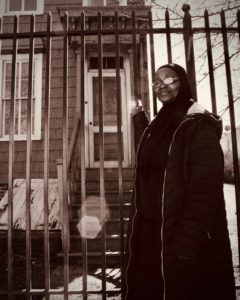
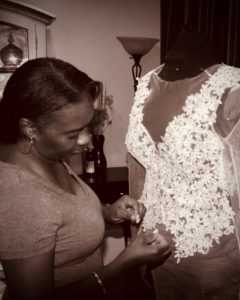
I have two new images to share, and look forward to meeting with you all tomorrow.
Lamar Ok
Weekly Reading Response Due Monday, March 25th, 2019
I am thinking about my art project of freedom dreams, utopia/dystopia and hope. Inspired by Wendy’s art-based exhibition presentation after class last week, aside from collecting drawings, I want to add another visual component or auditory component to go with the drawings of students. I maybe want to videotape and/or just record the voices of students speaking about their drawings. I want to minimize my interpretation of their work by having them answer:
Let me know what yall think! Should I use imovie? What’s a good beginners video program?
I recently collected drawings from 3rd grade students on what hope means to them.
Click on the link below to see one of my 3rd grade classes’ hope drawings: (27 of them):
“The role of the artist is to make the revolution irresistible.”
—Toni Cade Bambara, via Adrienne Maree Brown’s book, Pleasure Activism
“Photography is a way of feeling, of touching, of loving. What you have caught on film is captured forever… It remembers little things, long after you have forgotten everything.”
“I feel it is the heart, not the eye, that should determine the content of the photograph. What the eye sees is it’s own. What the heart can perceive is a very different matter.”
I was hesitant to comment on the readings prior to class for various reasons. Mainly, I struggled to reconcile the positionality of the researcher in relation to the underserved participants of this ethnography. Especially when we consider the role educational research has played to reproduce the dominant narratives and values of white supremacy, one could understand my skepticism/hesitancy. But I digress…
Upon completing the reading the first few questions that came to mind were:
Why did Luttrell choose this particular subject and narratives? and what is social justice within this subject?
How much work had Luttrell done around interrogating her whiteness and how it carries into her work? and has she consider its implications in her interaction with these students
I could go on… and what I quickly started to realize was that I was centering the positionality of the researcher in a way that didn’t allow for me to present to the voices the students in the research. So I took a step back and decided it engaged in conversation with colleagues and Luttrell before posting. This process allowed for another set of questions to emerge…
If we are the center the voices and narratives of the participants in our work, how do we maintain the integrity of those narratives while being transparent about our positionality in relation to the research and communities in which we seek to collaborate with in this work?
How did Luttrell navigate the absence of the photos and narratives that weren’t shared in the articles? Does the absence of these photos and narratives compromise the integrity of collective voice or “seeing” of the community of study?
Who is allowed to share what stories?
What I most appreciate about this week’s article and the talks was the intentionally and vulnerability Luttrell shared as she discussed some of her struggles in maintaining the integrity of the voices. The use of photography lends itself in ways text is limited or vulnerable to further misinterpretation. Photovoice, depending on the implementation, redistributes power within the researcher-participant dynamic with participants directing the focus. I’m still developing the ways in which I intend to use arts-based research and visual methodology within my work. And I’m inspired in the by the possibilities it invites in how I may collaborate and share narratives in my work.
As for the questions above, I don’t know that I have the answers…but I do have thoughts that….
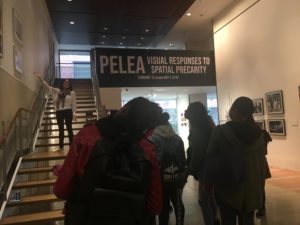
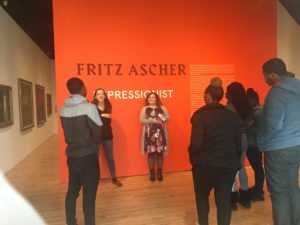
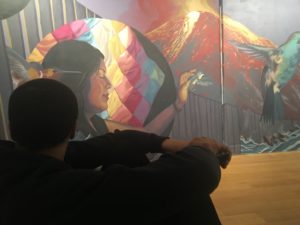
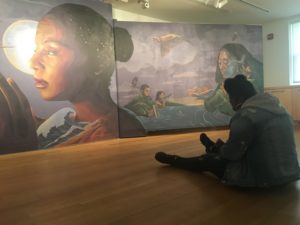
I enjoyed the readings for this week and they provided a powerful through line to my interest in collage and the relational and affective process of making art and narrating intergenerational experiences of black women and girls. Reading the article on photovoice and the collaging of young pregnant women left me wondering what it would like to place those processes in dialogue with each other for my class project? What if the girls and women took photos of their worlds while inserting the imaginary, natural, media images? How might this shift the dialogue in the space and on the paper? While thinking of the origin of photography and bodies specifically in the historical lives of black women and girls, I think of photos as violent exploitation, specifically pornographic voyeurism of white male social scientists. Further, I am reminded of Sara Baartman, and how black women and girl’s bodies were placed on display for inspection, exploitation and economic gain. I am brought back to this when thinking of the “immense danger associated with changing bodies and blossoming female sexuality” (54) and Anne Cheng’s assertion that “we don’t know enough about how racialized people as complex psychical beings deal with the objecthood thrust upon them…within the reductive notion of “internalization” lies a world of relations that is as much about surviving grief as embodying it.”(20) I wonder about this as I read the dialogue of the girls as they focus in and question each other’s physical characteristics and representation at various levels. I wonder about the interplay of time space in collaborative seeing? I wonder about how “the complex evocation of the children’s images and their context-dependent meaning can be preserved” within a photo, conversation, in the emotive registers and “embodied practices” (182) in the process of viewing and creating within intersectional black girlhoods? In this, I am also drawn to the “unknown girl.” I am curious about taking a critical bifocal lens and asking what part of her being unknown and thus separating herself is also a matter of social scientific research machine (Moynihan and others) that profits from the invention of a blackness and femaleness that represents and creates pathologies of poverty, pregnancy and violence while silencing the broader experience of poor white Americans? How white hegemony continues to obscure the material realities of generations of poor white folks and is also complicit in differing forms of racial exclusion inside and out of schools?
I also was thinking about how my own collage processing, where my human shape is never present but always reflected in a flow of ideas, colors and words. These readings also spoke to my role as an educator, who employs collage work regularly, and had me pause on the importance of prompts in art making. I am drawn back to Carol Gilligan’s push on the importance of offering an interviewee a real question, that is simple in its humanity and from a deeply mined place. A prompt must hold such complex simplicity as they provide a landscape for a certain type of exploration. I would love to learn more about the development of prompts for art-based research. For example, I am processing what it means to create a self-portrait versus a prompt to build a collage where you ask who am I? I loved the critical approach to collage making and centering the psychological associative logic that offers several pathways to interpretation and reinterpretation. I continued to think about the balance of being “glamourous” and that of a social justice art-based researcher and the constant anxieties that are produced in the process of trying to intercept hegemony, socially and psychologically and also create a space to be respected and safe. I appreciated how Luttrell weaves in her own narrative and emotionality in the process alongside the students. I am curious about, moments that she didn’t share in the article. If so, what were the other moments and how did she make the choice as to what to include? I am reminded of Kaela’s decision to paste a bright sun over her visit to the store. Where she clips and adjust her experience and what will be told in a purposeful manner. I was most blown away by the power of reading and viewing the teen’s reflexivity, curiosity and chatter as a heuristic for dialogic research processes. It is not the final result but the learning and growing that holds my attention throughout. I see this also reflected in Luttrell’s language, while sharing openly that much has changed in her own research over time and I also notice how the writing leaves gaps for curiosity and questioning. I appreciated the critical attention to power in the lives of children/people in the process of research and how tools, photography in this case, no matter how well intentioned is complicit in various forms of oppression. In response, I saw Luttrell speak back against simple first impressions and research that stand to further misrepresent the children, young women and families just as we saw Gabriel and Kendra share counter narratives in their photovoice projects.
I was also drawn to the “emotional landscapes” and the children’s and teen’s desire for “comfort, sense of belonging and respect”. I am curious about how Luttrell built her art research space? What did it look like? What sensory dynamics were important for her? I noted the use of “contraband” light music upon the young women’s request. This process of “homeplace” making called me to reflect on last Friday where I took my students on visual tour of three different spaces at NYU, one specifically on spatial precarity and another on sanctuary. PELEA: Visual Responses to Spatial Precarity https://wp.nyu.edu/latinxproject/event/pelea-visual-responses-to-spatial-precarity/, We Imagine Sanctuary: A Mural and Sound Installation http://apa.nyu.edu/we-imagine-sanctuary-a-mural-and-sound-installation-monday-february-25-friday-may-10-2019/ and Fritz Ascher: expressionist| Metamorphoses: Ovid Accoring to Wally Reinhardt https://greyartgallery.nyu.edu/exhibition/fritz-ascher-and-wally-reinhardt/
The youth’s emotive responses in each space were powerful and very diverse. PELEA students had a sense of feeling welcomed by the curator artist, warm feelings of familiarity, curiosity of whether racism was happening, beauty, nervous laughter and silence. The Sanctuary space slowed our pace, as we heard the audio recording share that “home is where my mother is” and other dreams and critical push towards survival in highly oppressed social positions. We sat in relaxed positions on the ground in the dimly lit space and named the place a sanctuary and wrote different ideas of peace “felt like grass with no wind. Just sun.” Students asked about the cost and the originality of a painting in the Fritz Ascher gallery. One student recently migrating from Chicago reinterpreted his expressionist flowers as explosions. Another poured over a book of poetry on a chair and another took a picture next to a sunset with a smile, stating this was her favorite. I am still processing the experience – as a sensory editing and remaking of visual art space – that takes on a sensory and dialogic component.